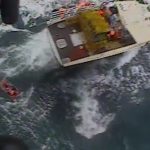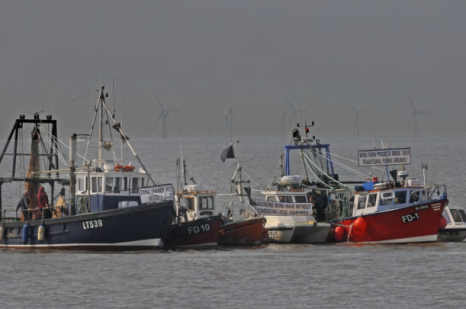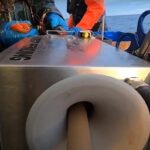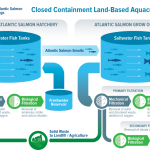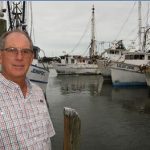Remembering Gosta “Swede” Lovgren
 Early last summer the fishing industry lost one of their loudest voices from the early years of federally managed fisheries when Gosta Lovgren of Lavallette New Jersey passed away less than two months after his wife of 55 years, Carol, died. He was born December 9 th 1938 and lived in Ocean County all his life. Affectionately known as “Swede” he was one of the first fishermen to understand the politics of the fishing industry and knew that if the industry did not become aware of, and fight, what was going to happen to them through management measures supposedly to save the fish, then they would be doomed. Swede was the leading industry voice in the fight against sludge dumping in the New York Bight and was the first person to understand and push for more involvement in fisheries from the New Jersey Farm Bureau, American Farm Bureau and the Department of Agriculture. His death was not widely reported as it happened in the middle of the Covid crisis, and he didn’t deserve to have passed away without the recognition he warranted.
Early last summer the fishing industry lost one of their loudest voices from the early years of federally managed fisheries when Gosta Lovgren of Lavallette New Jersey passed away less than two months after his wife of 55 years, Carol, died. He was born December 9 th 1938 and lived in Ocean County all his life. Affectionately known as “Swede” he was one of the first fishermen to understand the politics of the fishing industry and knew that if the industry did not become aware of, and fight, what was going to happen to them through management measures supposedly to save the fish, then they would be doomed. Swede was the leading industry voice in the fight against sludge dumping in the New York Bight and was the first person to understand and push for more involvement in fisheries from the New Jersey Farm Bureau, American Farm Bureau and the Department of Agriculture. His death was not widely reported as it happened in the middle of the Covid crisis, and he didn’t deserve to have passed away without the recognition he warranted.
Gosta started fishing with his dad in the Surf Clam fishery in 1960 and worked there until the Mid-Atlantic Council created their first fishery management plan and promptly put over 100 boats out of business including him. By that time, he owned his own Dock and business called Lovgren Enterprises located on Channel drive in Point Pleasant Beach, where he docked his 70 year old converted oyster schooner, the Carollelle. Kicked out of the clam industry, he switched his boat and dock over to successfully enter the booming New Jersey Whiting fishery, with his dock handling the landings of half a dozen boats daily and ignoring the local industry trip limits that stabilized the market. From the 1970’s thru the 1980’s when the media in New Jersey covered a fishing industry story, they always sought out Swede’s opinion, as while his language was colorful, he was very knowledgeable, insightful, and opinionated. [plus, he was never wrong, a family trait].
In 1976 the U.S. suffered what was, at the time the worst ecological disaster in our history with the great ocean kill in the New York Bight that covered hundreds of square miles of ocean bottom from New York City down to Atlantic city, and extended forty miles offshore. Every living bottom creature in the area died, with the Surf and Quahog populations being decimated, along with Lobsters and crabs, while most fish could swim away from the disaster. Swede recognized early on from the signs he was seeing in his dredges and the observations of other clammers that there was a serious unknown problem taking place and it probably had something to do with the huge sludge dump site located about fifteen miles east of Long Branch where millions of gallons of untreated sewerage was dumped every day. He hired a diver to get a sample of the bottom water near a local wreck and brought it to a meeting that had been arranged between a few local fishermen, the head of the regional EPA, and Congressman Jim Howard. Presenting the bottle to them he told the EPA head and the Congressman that they were not doing their job very well, in language that may not be suitable for all audiences. He continued this battle until it was won, over ten years later.
After passage of the Magnuson Act and the beginnings of fishery management plans Gosta knew that our industry needed to organize and he became involved in the New Jersey Farm Bureau, and actively encouraged local fishermen to join. Within a few years Gosta was the Ocean County Farm Bureau President, and served on the Board of Directors of the New Jersey Farm Bureau. He used his position to push fisheries issues into the mainstream of NJFB policies hoping eventually to get national involvement with the American Farm Bureau and their four million members. He was honored with the Art West distinguished service to the New Jersey Farm Bureau award in 1985 for his efforts. Swede recognized early on that the commercial fishing industry had absolutely no one in power that cared about them, and saw the agricultural community as brothers who faced similar problems but had much more support nationwide than fishermen. Since both industry’s harvested food, teaming up should be a no brainer, but politics is a complicated thing and agriculture had their own ideas about fish production, namely aquaculture, so his efforts nationwide were fruitless at that time, but still continue through the efforts of the NJFB.
In 1985, after being kicked out of the surf clam industry, fighting NMFS over two written violations, and seeing the authoritarian ruthlessness of an NMFS administrative law judge, Swede took out a full two-page ad in the National Fisherman magazine issue from May 1985 confronting the actions
of NMFS and the fishery management system they set up. When he finished writing the piece, he promptly suffered a massive stroke and almost died. He was left with paralysis on his left side, and his active involvement in fishing was ended. He had to sell his boat and the dock and concentrated on
rehabbing his body with a strenuous physical regimen that helped him regain some of his functions. He spent much time after the creation of the internet trying to beat the stock market, before creating his own award-winning website, Swede’s Dock, which covered all types of various issues, but mostly concerned fishing. Here he wrote many opinion pieces on fishing that are still relevant today. The website is still online, with an incredible amount of fishing information on fishery management, science, and even back yard ponds. In 2000 Gosta became a published author with his 178-page book, the “Ponder’s Bible, all you need to know to build and maintain your own pond”. It is still available on Amazon.
From Nils Stolpe; I knew Swede for almost all my professional career in fisheries. My dealings with him started when I was attempting to do fisheries support and development work for the New Jersey Department of Agriculture, a whole ‘nother story that I won’t get into here. At the time he was
fairly contemptuous of most of the bureaucrats, both federal and state, that were involved in [or were pretending to be involved in] fisheries, and he maintained a lot of that contempt for as long as I knew him. Fortunately, my life as a bureaucrat lasted for somewhat less than a decade, and I like to think that in the subsequent years some of his contempt for me became a limited bit of grudging respect. But he was still Swede, and while it took me quite awhile to figure it all out, I came to see that his contempt for the huge, and many of us would argue just about completely ineffectual-government fisheries bureaucracy was spot on. In essence his distrust of the lions share of fisheries bureaucrats-aka “fishcrats” thanks to a long running column in National Fisherman- was rooted in the real world and was about as prescient as any commercial fishing advocate’s predictions involving the ongoing demise of the commercial fishing industry in the United States. Though I don’t know for how long it will be there, parts
of Swede’s website, “Swede’s Dock”, is still available at http://www.exit109.com/~gosta/. While some of it will probably offend some folks, and other portions are definitely controversial, if you are interested in fisheries management, it is certainly worth a visit or ten.
By Jim Lovgren and Nils Stolpe

































